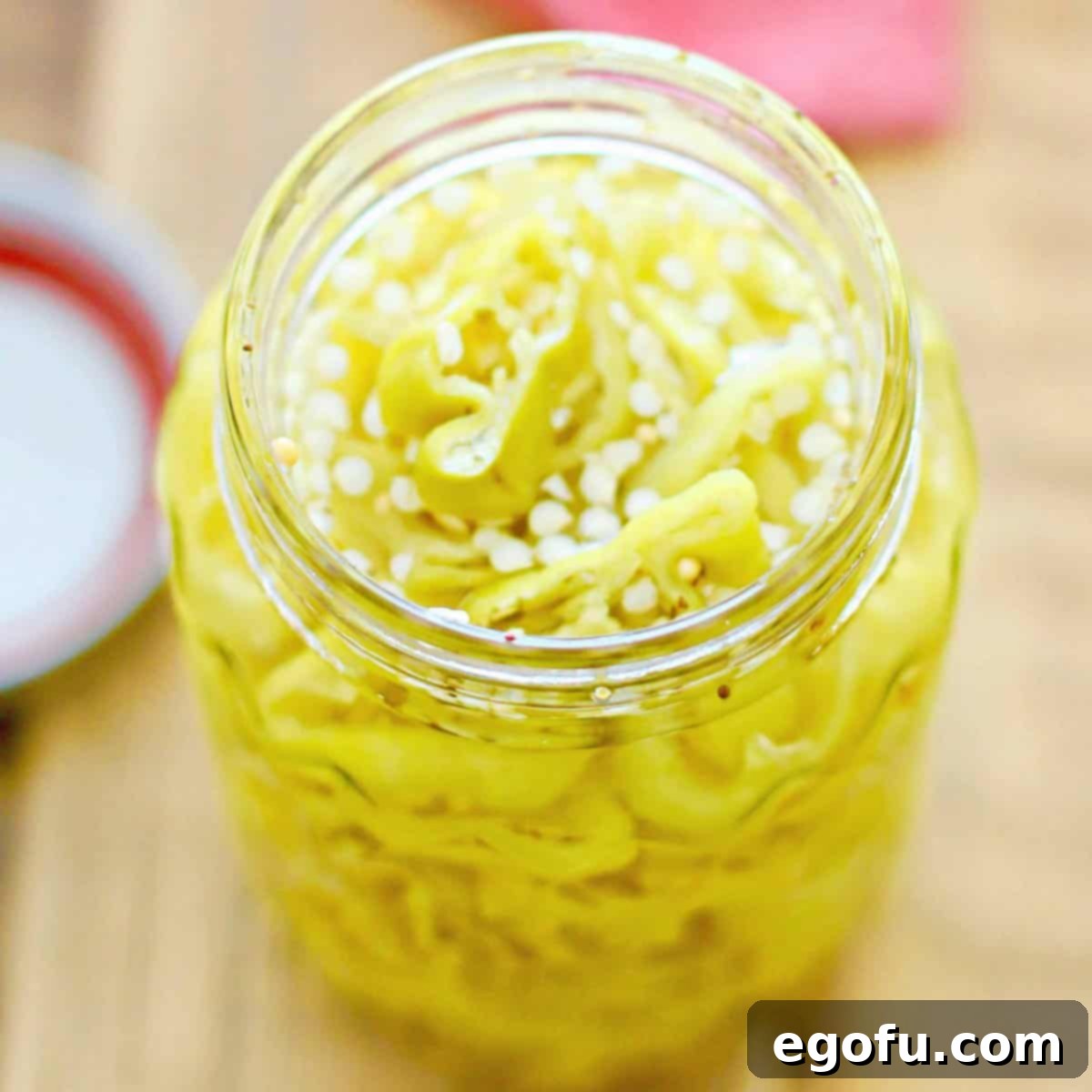Easy Pickled Banana Peppers: A Simple & Flavorful Homemade Recipe
Easy Pickled Banana Peppers are incredibly simple to make and bursting with fantastic flavor! All you need are a few basic ingredients like vinegar, mustard seed, celery seed, sugar, and of course, fresh banana peppers. This recipe is your go-to for preserving a garden bounty or simply enjoying a delightful, tangy condiment any time of year.
An Abundant Harvest: Why Pickling is the Perfect Solution
Gardeners often experience the simultaneous joy and challenge of a prolific harvest. One moment, your plants seem to be taking their time, and the next, you’re inundated with fresh produce! This year, my banana pepper plants truly outdid themselves. It was my first season growing them, and I was genuinely surprised by how much they yielded. While fresh banana peppers are wonderful, there’s only so many you can use immediately. This abundance is precisely what inspired me to create this simple yet incredibly delicious recipe for pickled banana peppers.
Pickling is a time-honored tradition that not only extends the life of fresh vegetables but also transforms their flavor into something truly extraordinary. For banana peppers, the pickling process infuses them with a vibrant tang, enhancing their natural crispness and subtle sweetness. This recipe is designed to be straightforward, using ingredients you likely already have in your pantry, making it accessible for even novice picklers. The result? A perfectly balanced, zesty condiment that you’ll want to put on everything.
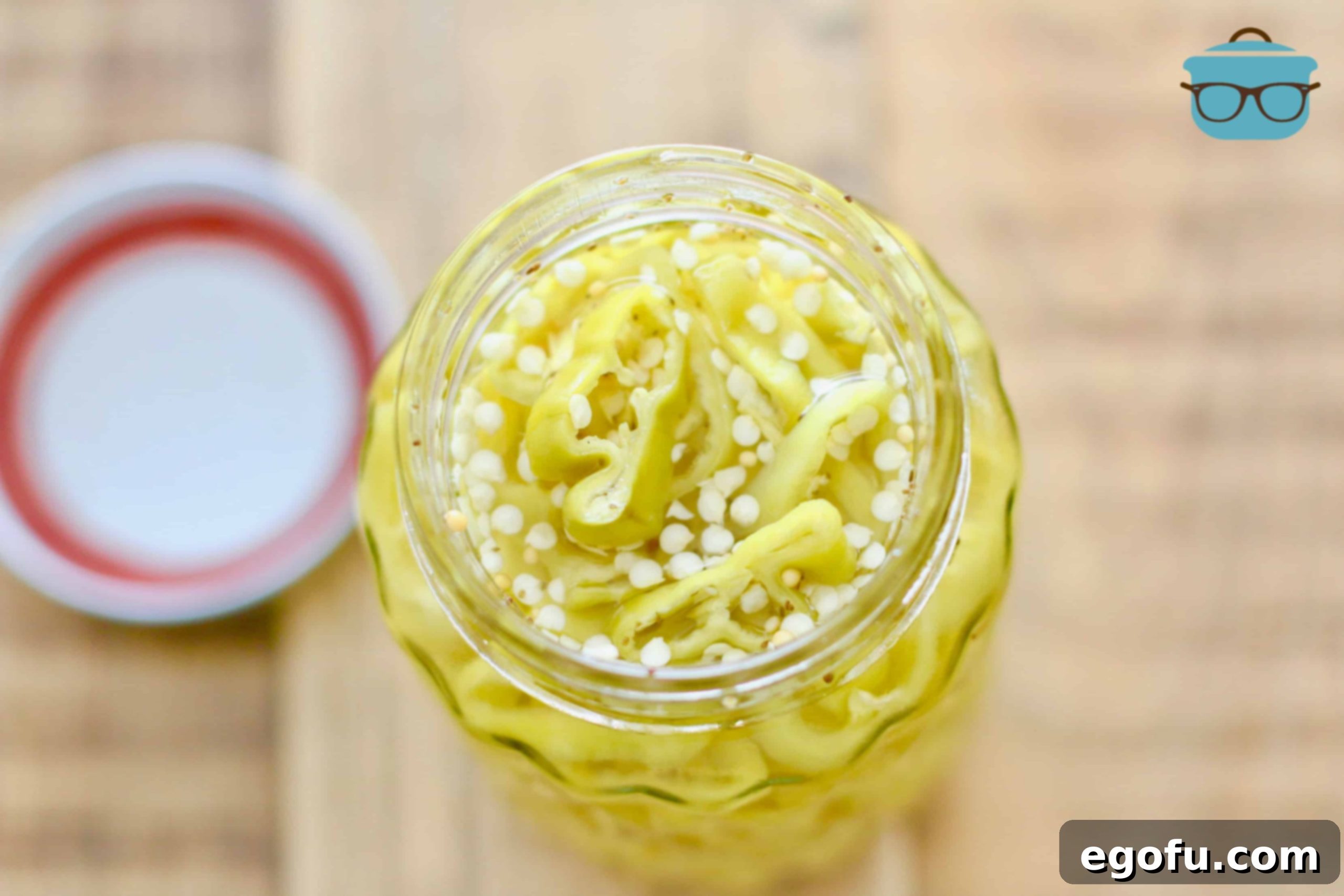

These were absolute perfection. They were not sweet at all. It was a nice balance with the vinegar. We are on our third batch already – thank you!
– Desiree
What to Do with All Those Banana Peppers? Endless Culinary Possibilities!
One of the best things about banana peppers, especially when pickled, is their incredible versatility. Before I started growing them, I primarily thought of them as a sandwich topping. However, after experiencing such a generous harvest, I quickly realized they could elevate a wide array of dishes.
My goal was to develop a simple recipe that would highlight the peppers’ natural attributes while complementing other flavors, rather than overwhelming them. This brine achieves just that, creating a delightful sweet-and-sour profile with aromatic undertones that make these peppers a fantastic addition to almost any meal. They’re excellent for adding a bright, tangy crunch to everything from salads and pizzas to tacos and charcuterie boards.
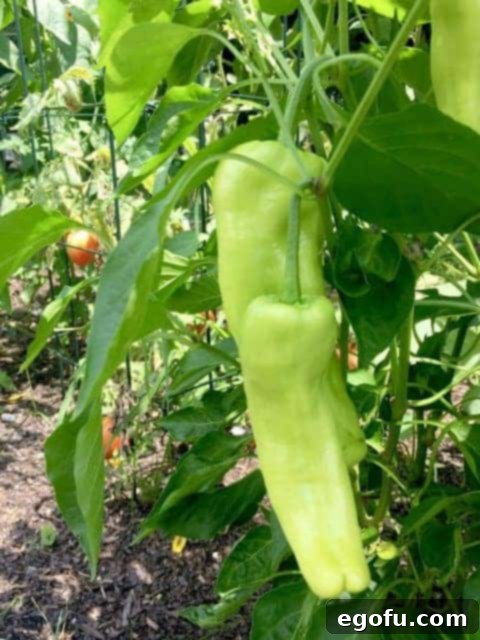
This recipe transforms your fresh banana peppers into a gourmet condiment that rivals any store-bought version, and it does so with minimal fuss. Plus, using your own homegrown produce or peppers from a local market ensures maximum freshness and flavor.
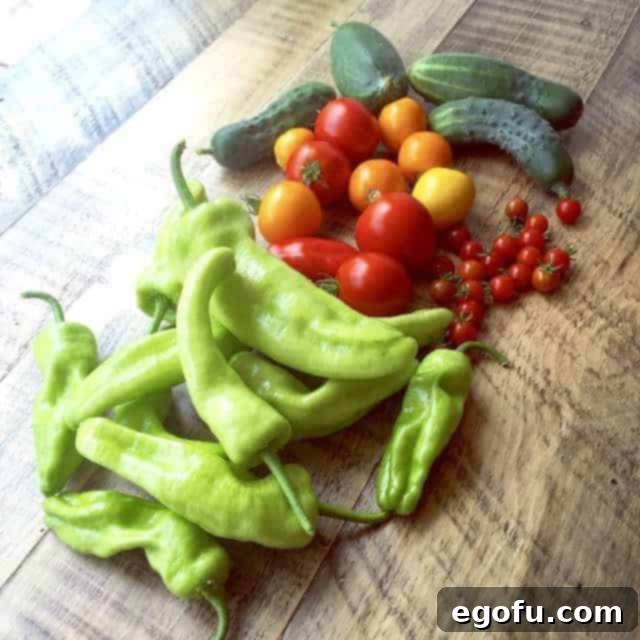
Are Banana Peppers Spicy? Unpacking Their Mild Charm
A common question about banana peppers is whether they pack any heat. The good news for those who prefer milder flavors is that banana peppers are not hot at all! They typically rank very low on the Scoville scale, often between 0 and 500 Scoville Heat Units (SHU), which is significantly less spicy than even a jalapeño.
Instead of heat, banana peppers offer a pleasant, sweet, and tangy flavor with a crisp texture. This makes them an ideal candidate for pickling, as the brine can introduce a new level of zest and complexity without any overpowering spice. In fact, these pickled banana peppers can be a fantastic substitute for peperoncini or other mild pickled peppers in many recipes. I was genuinely thrilled with the outcome of this recipe – the pickling process truly elevates their inherent flavors. This recipe yields two pint-sized jars, but it’s easily scalable; you can double or triple the ingredients to accommodate a larger harvest.
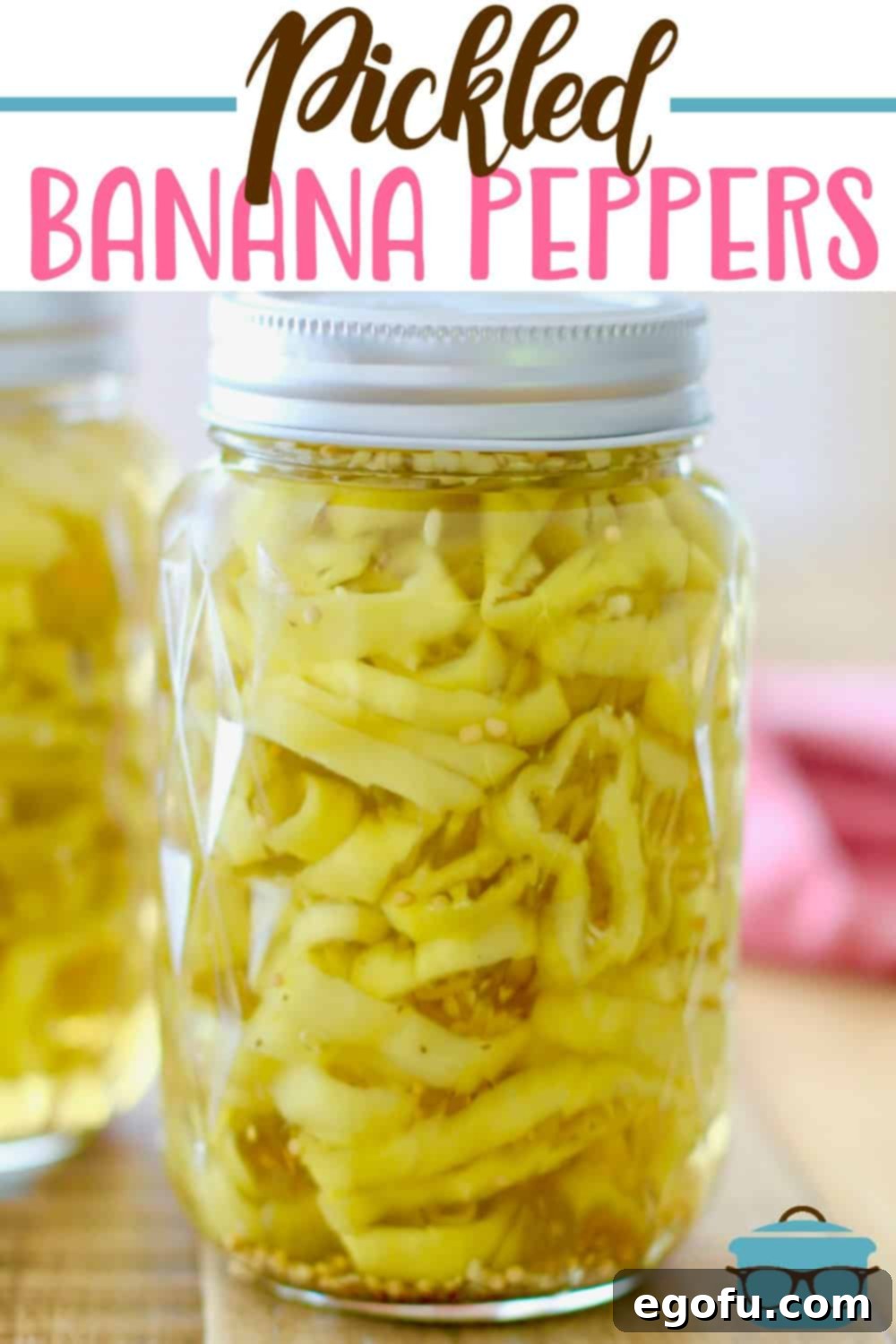
Ingredients Needed for a Flavorful Brine and Crisp Peppers
Crafting perfect pickled banana peppers starts with a selection of key ingredients. Each one contributes to the brine’s unique and delicious flavor profile:
- White Vinegar: This forms the essential acidic base of our pickling brine. Always opt for distilled white vinegar for a clean, sharp tang that beautifully preserves the peppers.
- Apple Cider Vinegar: While you could use all white vinegar, the addition of apple cider vinegar introduces a subtly fruity and mellow undertone. It adds an elevated layer of flavor and aroma that many standard pickling recipes lack, contributing to a more complex and well-rounded taste.
- White Sugar: A crucial ingredient for balancing the intense acidity of the vinegars. The sugar prevents the pickles from being overly sour, resulting in a harmonious sweet-and-sour profile that is incredibly appealing.
- Mustard Seeds: To me, these are an absolute must for authentic pickled flavor. Whole mustard seeds release their pungent, earthy notes slowly into the brine, creating a classic pickle taste. Ground mustard, while a potential substitute, is not recommended as it will make your brine very cloudy and alter the nuanced flavor profile. For the best results and clarity, invest in a small bottle of whole mustard seeds.
- Celery Seeds: This often-overlooked spice is what truly sets this recipe apart from others. Celery seeds impart a subtle, savory, and aromatic note that adds an intriguing depth to the brine. You won’t taste an overt “celery” flavor, but rather a unique “something extra” that elevates the overall taste and makes these pickles truly special.
- Banana Peppers: The star ingredient! Choose firm, fresh banana peppers, ideally straight from your garden or a local market. Make sure to rinse them well before preparing.
How to Make Easy Pickled Banana Peppers: A Step-by-Step Guide
This recipe is incredibly straightforward, ensuring a delicious batch of pickled banana peppers with minimal effort. Follow these simple steps for perfect results:
- Prepare the Brine: In a medium saucepan, combine the white vinegar, apple cider vinegar, white sugar, mustard seeds, and celery seeds. Bring this mixture to a rolling boil over medium-high heat, stirring frequently to ensure the sugar fully dissolves. A rolling boil indicates the liquid is bubbling vigorously and continuously.
- Pack the Peppers: While the brine is heating, thoroughly rinse your fresh banana peppers. Remove the tops and slice them into uniform rings. Tightly pack these sliced peppers into clean pint-sized canning jars, ensuring they are snug but not crushed.
- Pour the Brine: Carefully pour the hot pickling brine over the packed banana peppers in each jar. Fill them to within ½ inch of the top rim of the jar. This space, known as headspace, is important for proper sealing and to prevent liquid from overflowing.
- Seal the Jars: Using a clean, damp cloth, wipe any brine residue from the rims of the jars. Place a clean, new canning lid on each jar, followed by a screw band. Tighten the screw bands to fingertip-tight – meaning, tighten until you feel resistance, then stop. Avoid overtightening.
- Cool and Store: Allow the jars to cool completely at room temperature. As they cool, the lids should seal, indicated by a “pop” sound and the center of the lid pulling down. Once cooled, store your freshly pickled banana peppers in the refrigerator.
- Marinate for Flavor: For the best flavor development, resist the urge to dig in immediately! Allow the peppers to marinate in the brine for at least one week, or even longer. This waiting period allows the flavors to fully meld and deepen, resulting in a superior pickled pepper.
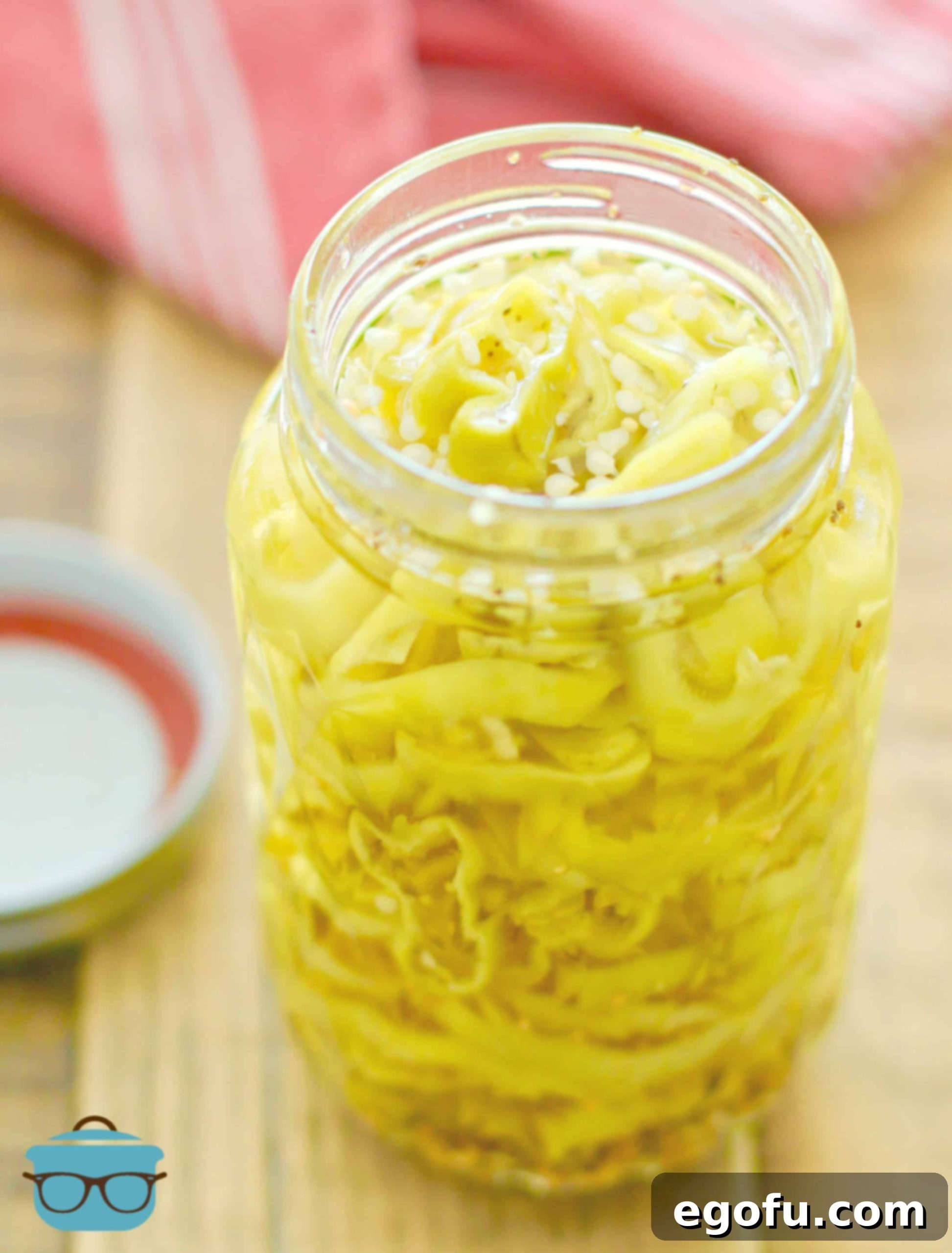
Tips for Pickling Banana Peppers Like a Pro
To ensure your pickled banana peppers are consistently perfect, keep these essential tips in mind:
- Refrigeration is Key for Quick Pickles: This recipe, as presented, makes “refrigerator pickles.” This means they are not processed for shelf-stability and must be kept refrigerated. When stored in the fridge, they will maintain their quality for up to 3 months. If you prefer to make them shelf-stable for longer storage outside the refrigerator, you must follow proper canning procedures. This involves sterilizing your jars and processing them in a water bath canner according to the latest USDA guidelines for your altitude and jar size. Always verify that the lids have completely sealed (the center of the lid should be concave and not flex when pressed) before storing on the shelf.
- Freshness of Peppers: Always use banana peppers that are firm, unblemished, and fresh. Thoroughly rinse them under cold water before slicing to remove any dirt or debris.
- To Seed or Not to Seed: The decision to keep the seeds in or remove them is entirely a matter of personal preference. Banana pepper seeds are not inherently spicy, so leaving a few in will not significantly impact the mild flavor or heat level. I usually try to remove most of them during slicing, but I don’t fuss if a few remain – it doesn’t affect the taste at all.
- Mustard Seed vs. Ground Mustard – An Important Distinction: This is a frequently asked question, and it’s important to clarify. While ground mustard can technically be substituted for whole mustard seeds, it is highly not recommended. Using ground mustard will make your pickling brine quite cloudy, affecting its visual appeal, and more importantly, it will not deliver the same distinct, vibrant flavor profile as whole mustard seeds. For the best possible taste and a clear, appealing brine, please purchase whole mustard seeds. They are worth the small investment and truly make a difference in the final product.
Craving More Pickled Delights and Hearty Meals?
If you’ve enjoyed making these easy pickled banana peppers, you might be interested in exploring other delicious recipes that capture the essence of homemade goodness. Here are some of our favorites:
- Refrigerator Pickles: Another simple way to enjoy crisp, tangy pickles without extensive canning.
- Sweet Pickle Relish: Perfect for hot dogs, burgers, and tuna salad.
- Pickled Red Onions: A vibrant, tangy topping for tacos, salads, and sandwiches.
- Dill Pickle Relish: A savory complement to any meal.
- Crock Pot Mississippi Pot Roast: A tender, flavorful main course.
- Italian Chopped Salad: Fresh and zesty with a homemade dressing.
- Crock Pot Beef Dip Sandwiches: Comfort food at its finest, where pickled peppers would be an excellent side!
- Cornbread Chicken Casserole: A hearty and satisfying family meal.
- Muffaletta Sandwich: A New Orleans classic, where tangy elements are key.
- Italian Melt: Another great sandwich that would benefit from a side of pickled banana peppers.
- Chow Chow: A Southern pickled vegetable relish.
- Creamy Cucumber Salad: A refreshing side dish.
- Quick Sauerkraut: Fast and easy fermented cabbage.
- Homemade Sauerkraut (Fermented): For those who love traditional fermentation.
Easy Pickled Banana Peppers
Easy Pickled Banana Peppers are super simple to make and so tasty! Vinegar, mustard seed, celery seed, sugar, and peppers are all you need for this delightful homemade condiment.
Total Time: 25 minutes
Ingredients
- 2 cups white vinegar
- 2 cups apple cider vinegar
- 1 cup sugar
- 1 teaspoon mustard seed
- 1 teaspoon celery seed
- 1 pound banana peppers, tops removed then sliced into rings (see notes below about the seeds)
Instructions
- Bring the vinegar, sugar, mustard seed, and celery seed to a rolling boil.
- Pour brine over peppers to within ½” of the top.
- Wipe off the rim and put lid and ring on. Allow to cool then put in the refrigerator.
- Leave for 1 week or longer to let peppers marinate (if you can wait that long!)
- You can also follow proper canning procedures and then process them in a water bath canner if you prefer. Follow the USDA guidelines for proper sterilization and timing. Be sure to verify that the lids have completely sealed down if storing on the shelf.
Notes
- Please refer to my post and ingredient list above to find answers to the most commonly asked questions.
- If you aren’t sterilizing the jars (for shelf-stable canning), these refrigerator pickles must be kept refrigerated. They will last up to 3 months in the fridge.
- Ground mustard can be substituted for mustard seed if you absolutely must, but it is not recommended at all. It will make your pickling brine pretty cloudy and it will not yield the same flavor profile as using whole mustard seed. Please keep that in mind. For best results, purchase a small bottle of mustard seed – it really makes a difference.
- Keeping the banana pepper seeds in or not is personal preference. I usually get most of the seeds out, but there are always a few that stay in there, and it doesn’t affect taste at all. I don’t fuss too much over that.
- This recipe makes 2 pints.
Nutrition
Carbohydrates: 19g |
Sodium: 8mg |
Fiber: 1g |
Sugar: 17g
Nutritional Disclaimer
“The Country Cook” is not a dietician or nutritionist, and any nutritional information shared is an estimate. If calorie count and other nutritional values are important to you, we recommend running the ingredients through whichever online nutritional calculator you prefer. Calories and other nutritional values can vary quite a bit depending on which brands were used.
Share it on Instagram @thecountrycook and mention us #thecountrycook!
